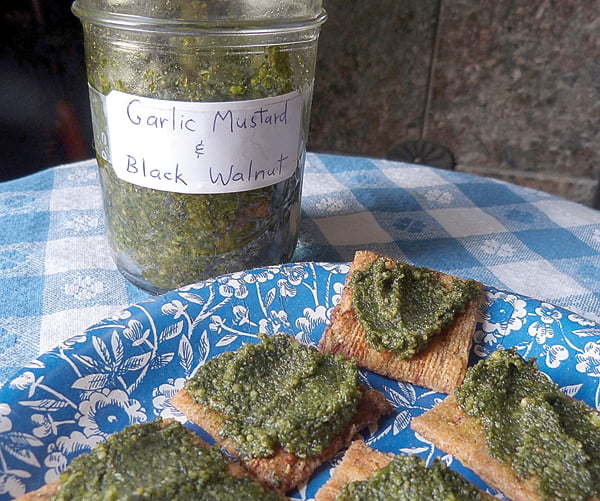
Ken Springer
Watoga Park Foundation
A tree for all seasons ~ the black walnut
Part One
During this self-imposed quarantine, I am grateful for having friends capable of conversing on a variety of subjects. And, for this reason alone, I wish for the end of this period of isolation so that our libraries, bars and coffee shops can reopen.
These are places where ideas flourish and are given voice; where one renews the connections with others that are so important to our continued health and well-being.
I had such a conversation recently with friends Jim and Beth Bullard who have both lived lives of rich experiences. We broached so many subjects in one sitting that I lost track of the segues between the often unrelated topics.
This discussion was a three-way stream of collective consciousness, facilitated by free-association, and perhaps a little wine, as well. We tackled everything from the question of “free will” to the flavor of morels fried in butter; eventually arriving at memories of husking black walnuts as youngsters.
On this subject, we tarried a while. Collecting, husking and prying the meat out of the tough shell of black walnuts was an autumn tradition for many folks of our age.
To let these fine nuts fall to the ground and not force the squirrels to share this bounty was sacrilege in many households. After all, we were the sons and daughters of those who suffered through the Great Depression, where no food was wasted.
After the walnuts fell from the tree in early fall they were collected in burlap sacks. The sacks were positioned on the road so that a vehicle could run over them a few times to loosen up the tough husks that seemed determined to cling to the nuts rough exterior.
Beth Bullard recalled husking walnuts as a young girl and going to school afterward to find many other classmates who also had darkly stained hands. Stains that would persist for a week or more and that even Lava soap wouldn’t remove.
My own memories of collecting walnuts involved driving slowly along country roads. There were only two times each year when we kids were allowed to ride on the running board of the truck – when morels were up and when black walnuts were down.
We were the sharp-eyed scouts for walnuts and mushrooms; a job we approached seriously and with great zeal.
We would shout “Eureka” when we spotted the green nuts peppering the road ahead and the truck immediately came to a stop. The nuts were quickly gathered up and placed into burlap sacks. Then we stood off to the side as the driver ran over the nuts, the juice of the fruit oozing through the sacks.
Returning home, the children would rip the green husk from the shells with bare hands. The resulting stained hands were a badge of honor and we felt sorry for the kids, who, for whatever reasons, were deprived of this activity.
I remember that we were instructed to carry out the husking a good distance from the garden. At the time I didn’t know why; it would be a few years later when I was out hunting morels with an uncle, that I learned the true power of the walnut tree, at least where certain other plants and animals are concerned.
After husking the walnuts, they were removed to a dry part of the basement where they were arranged on cardboard. Here they were left to dry for a month or so. With childhood patience beginning to run low, we finally arrived at the time when we would crack the nuts and dig the oily flesh from the brain-like structure of the shell.
I’m sure there are modern appliances available these days for cracking open black walnut shells; however, the ones used for English walnuts and almonds were not up to the task.
The shells are thick and tough, requiring far more force than a hand-held nutcracker. This was a job for a ball-peen hammer and a small anvil and, in my case, a one-foot section of railroad track. (How the adults obtained this ready-made anvil, I never knew.)
For many, digging and prying out these flavorful nutmeats is associated with the holidays. Indeed, they would be used in cookies, cakes and other baked goods. And in many a child’s opinion, the favorite use of the nut was in black walnut fudge. Put that in my stocking!
In the days following the discussion with Jim and Beth it began to occur to me that the black walnut tree has few equals in terms of the diversity of its products and its secret underground life. Juglans nigra is at once a prince of a tree, sharing its bounty with other trees, and a ruthless hit man for certain other plants it deems undesirable.
In the next episode of the Watoga Trail Report we will examine the many uses for black walnut in woodworking, not the least of which is a long history of customers demanding walnut be used on the stocks of high-quality firearms.
We will hear from artisans who praise the beauty and durability of black walnut items turned into works of art on a lathe.
We will discuss other uses for the black walnut tree from the manufacture of dyes to its contribution to the popularity of the English Walnut. You know, the kind of walnut that you see in every grocery store.
Would you believe that black walnut trees communicate with other species of trees through an underground network? And in doing so, often helps other trees at its own expense?
We will discuss why you can cause serious health problems to a horse by shoveling black walnut chips into its stall. And that Native Americans used black walnuts to catch fish without a hook or line.
Stay tuned to find out more about the amazing black walnut tree.
And in the meantime, stay healthy.
Ken Springer
Ken49bon@gmail.com


